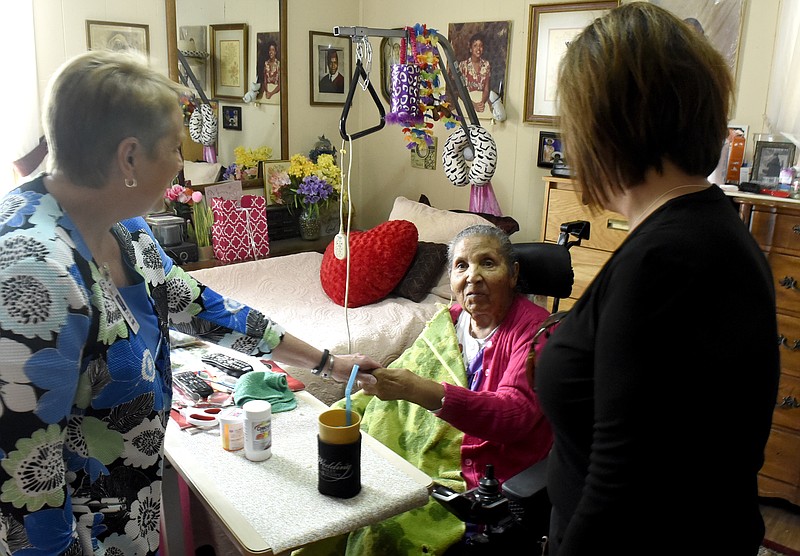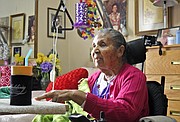Tennessee is turning gray, and stagnant funds coupled with limited capacity in state programs struggling to meet the demands of a rapidly aging population have many looking to the future with uncertainty.
About 1.57 million adults aged 60 and older live in Tennessee now, and that number is projected to grow to 2.16 million by 2030, according to a new state report. Here in Hamilton County, the number of adults 65 and older is also expected to grow in the next 13 years, from about 51,000 to 89,000, or 51 percent.
And as the number of older adults multiplies, so will the challenges associated with meeting their needs.
"We're just trying to do what's best for older adults in our state, but this is a national and even a worldwide issue," said Emily Long, a research and policy analyst for the Tennessee Commission on Aging and Disability, which released the report this month.
The two biggest hurdles facing the state are caring for its seniors on a shoestring budget and preparing to serve an expanding population fueled by baby boomers.
Each year, the federal Older Americans Act gives states money to fund senior services, but that funding - $1.8 billion in 2004 compared to $1.9 billion in 2016 - can't keep up with inflation or population growth, and questions surround its future as the Trump administration touts plans to cut federal spending.
Tennessee gets about $24 million in Older Americans Act funds, and the state also kicks in about $13 million. But officials say that funding isn't enough for today's seniors, much less tomorrow's.
There are more than 8,000 Tennesseans on wait lists for government programs that provide essential services, such as personal care, homemaking and home-delivered meals to older adults, said Kathy Zamata, deputy director of the Tennessee Commission on Aging and Disability.
"We have long waiting lists, especially for the in-home services," Zamata said. "We did get an extra $1 million this past year from the governor's budget, and we are truly grateful for that; however, when you spread $1 million over nine regions, you're not able to serve another 8,000 people."
With minimal in-home services costing $3,500 a year per individual, about $28 million would need to be added to the current budget to clear the lists.
Criss Grant - director of the Southeast Tennessee Area Agency on Aging and Disability, which oversees Hamilton and nine surrounding counties - said her agency also could serve more people if it had more resources.
"We just try to do the best we can with the dollars that are available," Grant said, adding her agency could play a role in helping the community find other ways to meet the demand. "We've got to come up with those answers sooner than later."
The report found many seniors have unmet transportation, nutritional, financial, housing and health care needs.
"Transportation is a huge issue," Grant said. "People that don't actually need assistance in the home can't get to the grocery store, can't get to their doctors visits and it just escalates after that."
For 10 years, 104-year-old Chattanooga resident Mollie Abernathy has relied on National Family Caregiver Support Program services for some meals, help with bathing and purchasing medical supplies not covered by insurance.
Abernathy is no stranger to caregiving. She's raised six children and took care of her husband and three sisters before their deaths.
"That's my duty, if I'm able," she said.
But her age and a stroke left her too frail to care for herself, so she now relies on her son and sole caretaker, John Abernathy Jr.
"It takes a lot of burden off," John Abernathy said, adding that the in-home bathing service is especially helpful, since the mother-son dynamic makes bath time awkward.
"I think it's made a big difference just in her survival - just to make it to 100 - without them, I don't think we'd have made it," he said.
Because of the program, Mollie Abernathy is able to remain in her home, surrounded by the things she loves, like flowers, her hat collection and chocolate MoonPies.
Home-delivered meals is another high-need, in-home service drowning in demand, with 450 people on the waitlist in the Southeast Tennessee area. The service provides one meal Monday through Friday to individuals age 60 and older who are unable to prepare food without assistance and are alone in the household at lunchtime.
Stacie Smith manages the program for the Southeast Tennessee area. She said that for some meals recipients, the volunteer delivering the food is the only person they see all day.
"A lot of our clients have said it's enabled them to stay home longer because they have not just that nutrition, but they have that daily check," Smith said. "We've gone in many times on a Monday, and we've found people that have fallen over the weekend and nobody knew, so that's how important that safety check is."
Cathy Scott, a social work professor at the University of Tennessee at Chattanooga who teaches gerontology, said keeping older adults in their homes when possible is "the best-case scenario" for their mental well-being.
"Research shows that aging in your community dwelling place, where you live, you fare better," Scott said. "That's why I think aging in place and home and community-based services are very important."
There are also economic advantages to aging in place.
For $3,500 to $15,000 a year, the state can keep someone like Mollie Abernathy at home instead of it paying for her to be in a nursing home, which can cost more than $50,000 a year in the Southeast.
"It's a good investment," Grant said. "The problem is we're not investing enough now to meet the need for the future."
Zamata recommends that as people plan for their older years, they consider savings, long-term care insurance and trying not to depend upon services that may or may not be available.
But despite the obstacles, she remains optimistic.
"Everything is not dependent upon the state and federal funding," Zamata said. "Many people never touch that funding, they've got their private insurance, they're aging in place, they're doing their own thing."
Scott said she sees a growing interest in gerontology - the study of aging - among her students, who recognize the opportunities that come with the changing demographic.
"Chattanooga is actually becoming a retirement community or a settlement place for older adults across the country, and because of that, a lot of the system - social services, medical services, higher education - recognizes that," she said.
The state report cites several focus areas for the future, including ensuring that programs are efficient and effective, developing community partnerships to reduce gaps in services and providing citizens with more access to information about aging issues and healthy living.
"I think the more older individuals we have, the more awareness there is," Long said. "That knowledge is really growing, and I think that's exciting."
Contact staff writer Elizabeth Fite at efite@timesfreepress.com or 423-757-6673.

